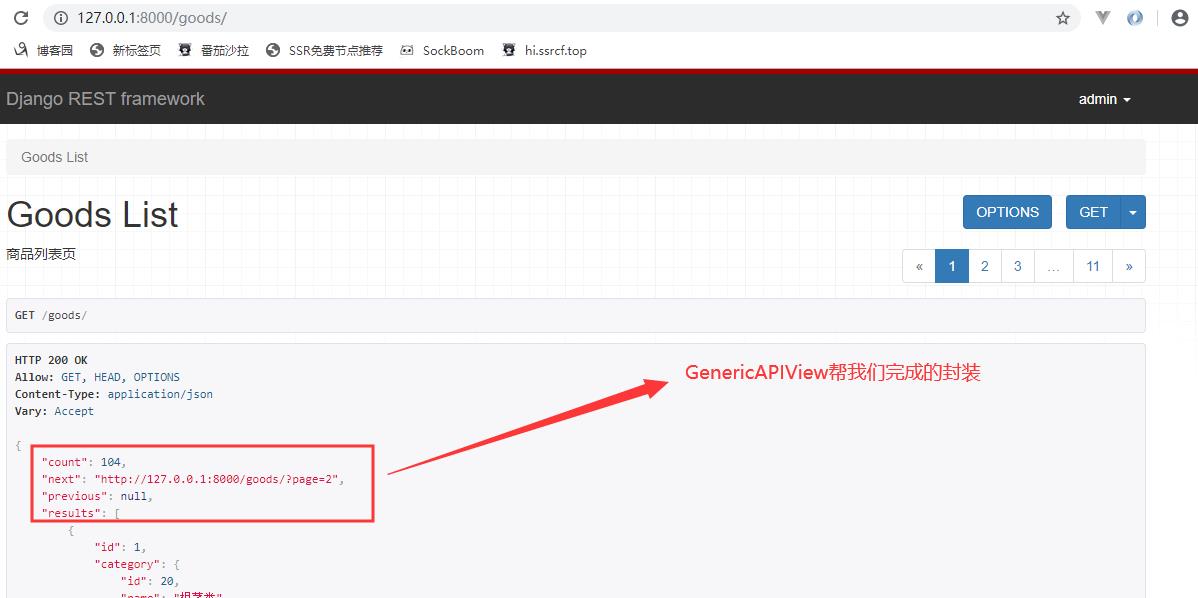(生鲜项目)08. ModelSerializer 实现商品列表页, 使用Mixin来实现返回, 以及更加方便的ListAPIView, 以及分页的设置
Posted 红虾
tags:
篇首语:本文由小常识网(cha138.com)小编为大家整理,主要介绍了(生鲜项目)08. ModelSerializer 实现商品列表页, 使用Mixin来实现返回, 以及更加方便的ListAPIView, 以及分页的设置相关的知识,希望对你有一定的参考价值。
第一步: 学会使用ModelSerializer, 并且会使用ModelSerializer相互嵌套功能
1. goods.serializers.py
from rest_framework import serializers from goods.models import Goods, GoodsCategory # 让goods的category字段全量显示 class CategorySerializer(serializers.ModelSerializer): class Meta: model = GoodsCategory fields = "__all__" # 取所有字段 # 方式一 # class GoodsSerializer(serializers.Serializer): # name = serializers.CharField(required=True, max_length=100) # click_num = serializers.IntegerField(default=0) # goods_front_image=serializers.ImageField() # 方式二: 用ModelSerializer class GoodsSerializer(serializers.ModelSerializer): category = CategorySerializer() # 重写category字段,从而实现ModelSerializer的嵌套 class Meta: model = Goods # fields = ("name", "click_num", "market_price", "add_time") fields = "__all__" # 取所有字段
2 . 刷新网页看看结果

第二步: 使用Mixin来实现返回
goods.views.py
from rest_framework import mixins from rest_framework import generics from rest_framework.views import APIView from rest_framework.response import Response from .models import Goods from .serializers import GoodsSerializer # # 方式一, APIview继承了View # class GoodsListView(APIView): # """ # List all snippets, or create a new snippet. # """ # # def get(self, request, format=None): # goods = Goods.objects.all()[:10] # goods_serializer = GoodsSerializer(goods, many=True) # many:是否是querrySet对象 # return Response(goods_serializer.data) # # 方式二: 利用mixins.ListModelMixin, generics.GenericAPIView # class GoodsListView(mixins.ListModelMixin, generics.GenericAPIView): # """ # 商品列表页 # """ # queryset = Goods.objects.all()[:10] # serializer_class = GoodsSerializer # # def get(self, request, *args, **kwargs): # return self.list(request, *args, **kwargs) # # 方式三,使用更加简便的generics.ListAPIView # # 原理就是: ListAPIView里面继承了mixins.ListModelMixin, generics.GenericAPIView, 而且还封装了返回 class GoodsListView(generics.ListAPIView): """ 商品列表页 """ queryset = Goods.objects.all() serializer_class = GoodsSerializer
第三步: 分页的设置
方法一: 在settings里面设置REST_FRAMEWORK分页参数
settings.py
REST_FRAMEWORK = { # 解决 1.11.3版本下使用APIview会报\'CSRFCheck\' object has no attribute \'process_request\'的问题 # "DEFAULT_AUTHENTICATION_CLASSES": [], \'DEFAULT_PAGINATION_CLASS\': \'rest_framework.pagination.PageNumberPagination\', \'PAGE_SIZE\': 10, }
接着去刷新网页

还有下面这个img字段的url的拼接, 也是genericAPIView帮我们完成的

方法二: 在goods.view里面重写PageNumberPagination, 从而达到动态分页的目的, 这样前端就想怎么取就怎么取
goods.view.py
from rest_framework import mixins from rest_framework import generics from rest_framework.views import APIView from rest_framework.response import Response from rest_framework.pagination import PageNumberPagination # 自定义分页 from .models import Goods from .serializers import GoodsSerializer # 自定义分页功能, 并实现动态分页, 继承PageNumberPagination class GoodsPagination(PageNumberPagination): page_size = 10 page_size_query_param = \'page_size\' # 指定每一页显示多少条 page_query_param = "p" # 指定要第几页 max_page_size = 100 class GoodsListView(generics.ListAPIView): """ 商品列表页 """ queryset = Goods.objects.all() serializer_class = GoodsSerializer pagination_class = GoodsPagination # 需要指定分页的类
刷新网页试试

------ over ------
以上是关于(生鲜项目)08. ModelSerializer 实现商品列表页, 使用Mixin来实现返回, 以及更加方便的ListAPIView, 以及分页的设置的主要内容,如果未能解决你的问题,请参考以下文章